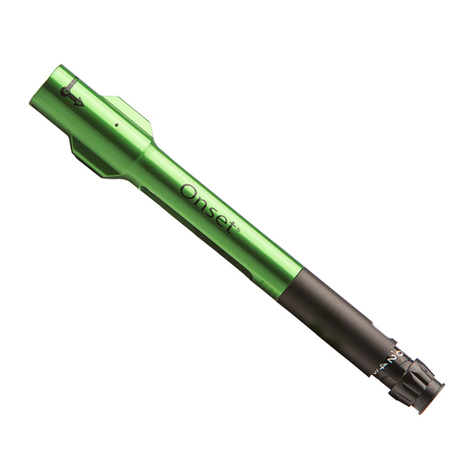
Prime the Onset Mixing Pen
1: Reset Piston Rod
Unscrew the dosing mechanism from the cartridge chamber and check to make sure the piston rod is fully
retracted.
If the piston rod is not fully retracted, as in Figure 1, grip the red reset mechanism with your thumb and fore-
nger and turn the dosing mechanism counter clockwise until the piston rod is fully retracted, as in Figure 2.
Onset Mixing Pen
The Onset Mixing Pen is a high-precision dispensing device for
mixing two solutions together. The pen is used to dispense a
solution from a standard 3 mL cartridge to a second uid container,
allowing the solutions to be mixed via a sterile uid path. For
example, the pen may be used to dispense sodium bicarbonate
8.4% USP buer solution to a standard 1.7 mL cartridge of lidocaine
with epinephrine to mix the solutions.
7
1
2
3
45 6
Dosing Mechanism
Cartridge Chamber
Figure 2
Piston Rod Fully Retracted
Figure 1
Piston Rod Not Retracted
Onset Mixing Pen Parts
1- Chamber Barrel 2- Cartridge Window 3- Piston Rod 4- Reset
Mechanism 5- Volume Window 6- Volume Dial 7- Dispensing
Button
Designed for safety and precision, the Onset Mixing Pen conveniently
provides a method for healthcare professionals to precisely and safely
mix two parenteral solutions prior to injection.
This Reference Guide provides a brief overview of setting up the pen
and mixing two solutions together using an Onset Cartridge Connec-
tor (sold separately by Onpharma). For more information, please refer
to the Instructions for Use provided with the Onset Mixing Pen.
In this Reference Guide, 3 mL cartridge refers to the sodium bicarbon-
ate pH buer solution sold by Onpharma, while 1.7 mL cartridge re-
fers to Lidocaine, Mepivicaine, Prilocaine, or Articaine solutions sold
by third parties.
2: Insert a 3 mL Cartridge
Insert a 3 mL cartridge (such as sodium bicarbonate
8.4% pH buer solution) into the small end of the pen’s
cartridge chamber with the septum entering rst, then
reattach the dosing mechanism.
3mL Cartridge
Buffering Chart
Dial 9
2% lidocaine 1:100,00 Ephinephrine
2% lidocaine 1:50,000 Ephinephrine
4% Articaine 1:100,000 Ephinephrine
4% Articaine 1:200,000 Ephinephrin
3% Mepivacaine
4% Prilocaine
4% Prilocaine 1:200,000 Ephinephrine
3: Prime the Onset Mixing Pen
After loading a new 3 mL cartridge, you must rst
prime the pen to ensure the piston rod makes con-
tact with the 3 mL cartridge.
Dial Volume to any Number
The 3ml cartridge contains spacer in addition to the
stopper. Prime against the spacer by dialing the pen
to a low setting (such as 9) and gently push the center
of the dispensing button straight down until you feel
the piston rod make contact with the 3 mL cartridge.
Use Onset with all your local anesthetic
injections to give you more control of
your daily schedule.
- Onset can help maximize the predict-
ability on same day procedures, even in
those patients with infections.
- After giving the injection buered with
Onset, stay with your patient instead of
leaving the operatory.
- Using Onset you can begin your proce-
dure much sooner versus using un-bu-
ered local anesthetic.























